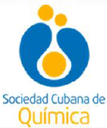
7th International Chemistry Symposium
SIQ 2019
In this work, the adsorption of chlordecone (CLD) on activated carbons prepared from sugar cane bagasse is evaluated and a theoretical study is done, aiming to understand the mechanism of CLD adsorption on the acidic AC surface. First, a physic-chemical characterization of the ACs were evaluated by thermal desorption, X-ray photoelectron and Boehm studies. Adsorption isotherms of CLD show that the adsorption capacity increases with the amount of carbon and by the presence of acidic groups (SGs) at the AC surface of chemically activated carbons. These results are in agreement with theoretical findings, where for deprotonated carboxyl and hydroxyl modifications of the AC model, significant associations with CLD suggest a chemical sorption at slightly acidic and neutral pH conditions. However, under acidic conditions (pH < 5) a non-dependence of the association energy with the SGs composition is observed. At basic pH conditions the interactions between the chlordecone hydrate (CLDh) and SGs onto AC are governed by dispersive interactions of chlorine atoms of CLD with the graphitic surface and by electrostatic interactions of CLDh with COO- and O- groups and water molecules. These results are confirmed by a Temperature-Programmed Desorption study, showing that CLD molecules are associated with carboxylic groups of the AC surface. As results, the best conditions for the adsorption of the CLD on AC with SGs are in the pH range between 5 and 9, as confirmed by the theoretical and the experimental results. An increase in carboxylic SGs content is proposed to enhance CLD adsorption onto AC.
In this work, the adsorption of chlordecone (CLD) on activated carbons prepared from sugar cane bagasse is evaluated and a theoretical study is done, aiming to understand the mechanism of CLD adsorption on the acidic AC surface. First, a physic-chemical characterization of the ACs were evaluated by thermal desorption, X-ray photoelectron and Boehm studies. Adsorption isotherms of CLD show that the adsorption capacity increases with the amount of carbon and by the presence of acidic groups (SGs) at the AC surface of chemically activated carbons. These results are in agreement with theoretical findings, where for deprotonated carboxyl and hydroxyl modifications of the AC model, significant associations with CLD suggest a chemical sorption at slightly acidic and neutral pH conditions. However, under acidic conditions (pH < 5) a non-dependence of the association energy with the SGs composition is observed. At basic pH conditions the interactions between the chlordecone hydrate (CLDh) and SGs onto AC are governed by dispersive interactions of chlorine atoms of CLD with the graphitic surface and by electrostatic interactions of CLDh with COO- and O- groups and water molecules. These results are confirmed by a Temperature-Programmed Desorption study, showing that CLD molecules are associated with carboxylic groups of the AC surface. As results, the best conditions for the adsorption of the CLD on AC with SGs are in the pH range between 5 and 9, as confirmed by the theoretical and the experimental results. An increase in carboxylic SGs content is proposed to enhance CLD adsorption onto AC.
About The Speaker

MsC. Kenia Melchor Rodríguez






